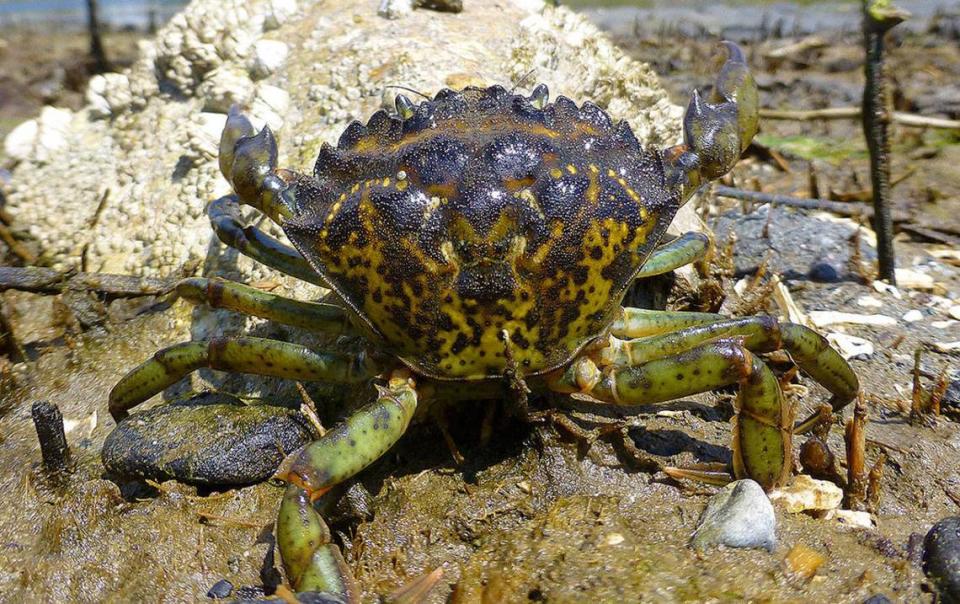One of the worst invasive species threatens WA waters. Here’s what to do if you see it
European green crabs are considered to be one of the world’s worst invasive species and a significant threat to the health of Washington’s marine waters.
Their destructive tendencies damage both critical habitat (like eelgrass beds) and other native species.
“I think the most concerning thing about European green crab is that they are excellent generalists, meaning they can eat all sorts of things,” said Stena Troyer, science specialist at the environmental education nonprofit Harbor WildWatch. “They have the potential to consume so many critical parts of the Salish Sea food web including oysters, clams, and Dungeness crab — all of which happen to be things that people value eating too.”
More than 105,300 European green crabs have been removed in Washington waters this year, with the tally recently at 752,047 total removals since Jan. 1, 2022.
Statewide efforts to control these crabs began in 2020 and public education efforts ramped up in 2022. While a very small population was detected in Hood Canal in 2022 and 2023, thankfully they still have not been detected in south Puget Sound.

Control and monitoring are managed through the combined efforts of the Washington Department of Fish and Wildlife-led coalition of tribal co-managers and partners, as well as Washington Sea Grant’s Crab Team. However, only a small fraction of the identified suitable nearshore habitat — which spans the entirety of the Puget Sound and Salish Sea — can be monitored by these teams.
That’s where the Molt Search Program comes in, calling on the public’s help to keep the south Puget Sound free of this invasive species and monitor shorelines throughout the Salish Sea.
How to identify crab species
Molt Search is a volunteer-based early detection program led by Washington Sea Grant and Washington State University. The program trains interested beachgoers to identify crab molts and report local findings. Better yet, Molt Search partners with local organizations across 12 Puget Sound counties to help lead programs.
Harbor WildWatch recently led a molt training at Titlow Beach Park and has incorporated molt searches into their biannual participatory science beach monitoring as well as their summer beach tours. They encourage interested beachgoers to reach out to Troyer about early detection trainings or come to one of their many educational beach tours over the summer.
Washington Sea Grant also has weekly trainings in-person and online across the Puget Sound.
“In-person trainings give you a hands-on experience identifying crab species which can be extra helpful when distinguishing a Dungeness crab from the similar Graceful crab,” said Troyer. “While we anticipate a bunch of ‘zeros’ reported in the South Sound, this is still an important number to record. Plus, when submitting reports, there is the opportunity to contribute data about Dungeness crab.”
The premise behind Molt Search is straightforward: set a timer and go on a personal scavenger hunt in the rack line of the shore where high tide stretched to and often remnants of seaweed remain. Beachgoers should specifically look for crab carapaces, the outer exoskeleton or shell of crabs. All crabs shed their carapaces when they grow, so looking for molts enables detection of populations when they are (hopefully) still small.
In fact, when European green crabs were originally detected in the late-1990s, the very first reports were not of molted shells rather than live crabs. According to Washington Sea Grant, the recent increases in their numbers are a crucial focus of population control for state managers and early detection is a high priority.
Report sightings immediately
The trickiest part of Molt Search is identifying any discoveries, which is where the trainings come in handy. Despite their name, European green crabs aren’t always green and can range from red to yellow depending on age. The best way to identify them is by counting the five prominent marginal teeth on their carapace, located near their eyes (for comparison, Dungeness and Graceful crabs have 10 prominent marginal teeth).
“The five marginal teeth on the wide eye side are the key to identifying this invasive crab,” said Troyer. “Here’s a fun memory tool: think of the five letters in the word ‘green’ as your key to remember the five marginal teeth from each eye of the European Green Crab. Then hold up your hand to give a ‘European green crab high-five.’”
Troyer offered another memory tool: European green crabs’ carapaces are wide on the eye side, kind of like your eyes might be if you were to come across one in the south Puget Sound.
If a carapace or live European green crab is identified, it can be reported through WDFW, Washington Sea Grant, or through the MyCoast app (which trainings help familiarize volunteers with). Any live findings should be left in place after being reported.
Though leaving crabs in place might sound counterintuitive, WDFW does not want native species to be incorrectly identified and accidentally killed. Leaving the crab and reporting it allows partners to investigate findings and set traps. If any European Green Crabs are caught in the traps, they are frozen and reutilized by WDFW as fertilizer.
“Trained or not, if you’ve found a European green crab, report it immediately,” said Troyer. “If it is a dead crab or a molt, WDFW requests that you hold on to the specimen so it can be verified. Sightings can be reported to the WDFW hotline at 1-888-WDFW-AIS.”
Community-involved programs like Molt Search provide important data for researchers and are imperative to having more boots on the ground to detect a highly invasive species. Put simply: the Puget Sound and Salish Sea have more than 2,000 miles of shoreline. Researchers and managers can’t cover these beaches alone, so searching for molts provides critical support to the early detection of these crabs before they establish large populations that would be difficult, or impossible, to control.
“The more folks we have on the beach reporting the presence and, more importantly, the absence of European Green Crab, the better for reacting to this potentially devastating invasion,” said Troyer.
--
See you on the shore for a molt search! I am retiring from The Peninsula Gateway newspaper after a wonderful five years of reporting on the local environment. Thank you for caring about your impact in our community and across the Salish Sea.

Carly Vester has been writing an environmental column for The Peninsula Gateway since 2019. Her storytelling focuses on the intersection of people and the outdoors — from adventures across the west, to our environment and the rich history surrounding it. Her documentary films have screened internationally and her writing has been published locally and regionally.

